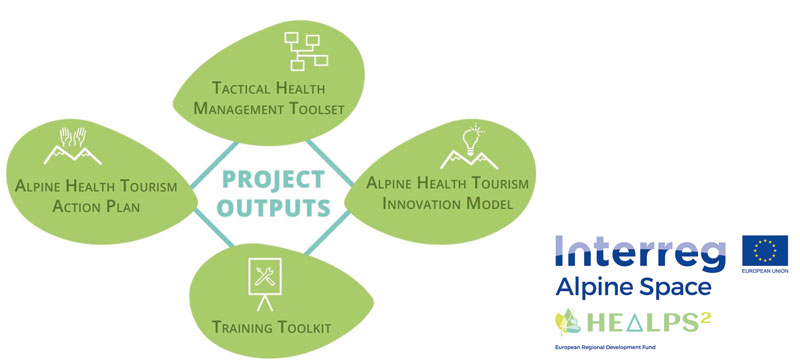by Daniele Spoladore, Elena Pessot and Marco Sacco (STIIMA-CNR)
The HEALPS 2 project is using digital solutions and stakeholder engagement to unlock the potential of health tourism in the alpine regions.
Health tourism is growing exponentially worldwide [1], as a consequence of changing lifestyles, the desire for nature-based experiences and the aging population. The wider definition of health tourism includes wellness tourism – dedicated to maintaining or enhancing personal health and well-being – and spa tourism – which exploits spa waters to heal or relax with the aim of curing or preventing health problems. The alpine regions of Europe, characterised by blue spaces (e.g. streams, pounds, lakes, etc.), high altitudes, and pristine landscapes, have the potential to play a pivotal role in nature-based health tourism. Nevertheless, the spatial fragmentation, the lack of access to knowledge and the little transversal cooperation between different stakeholders are hampering development of these regions.
The European project HEALPS 2 aims to help this industry grow by providing innovative ways of developing health tourism products and service chains. We are creating up-to-date digital solutions, informed by key stakeholders and recent research in the field of alpine health tourism. The outcome will be a “tactical health management toolset” to unlock the potential of alpine assets for value generation and best practice sharing. The digital tools will be developed and integrated in close collaboration with both existing and potential stakeholders, including tourism associations, policy-makers, regional developers, sectoral agencies and SMEs. The proposed approach will be tested in pilot regions where tourism, health and other relevant sectors will be engaged in a cross-fertilisation positioning of the alpine space as a globally recognised health-promoting region.
The set-up work of HEALPS 2 deals with the assessment of the core nature-based resources of alpine regions, including forests, moderate and high altitude , blue spaces (lakes, rivers, streams, ponds and waterfalls). An effective use of these resources can have positive impacts on visitors’ general health and can improve specific physical problems, such as back and joint pain, overweight, low levels of fitness, allergies and asthma and recovery following leg injury [2]. HEALPS 2 will help the development of nature-based health tourism products and fill in the knowledge gaps around marketing of health tourism in these regions by describing a set of KPIs to frame the nature-based regional features, together with the health-related services already provided by the SMEs operating in the regions (such as hydrotherapy, physiotherapy, healing caves and nature-based products). This information, combined with data about the benefits the services provide to specific target groups (tourists looking for nature-based health tourism to cure physical ailments), is invaluable when it comes to identifying development opportunities for alpine health tourism.
This knowledge is modelled and stored in a semantic data model that leverages the semantic web’s capabilities to formalise information (with first-order logic based languages RDF and OWL) and to enable automatic reasoning processes, including health-related data [3]. This feature can be used to provide SMEs and alpine tourist locations with a set of guidelines and reference practices on how to exploit the natural potential of the regions. Similarly, it is possible to advise health tourism operators about which target group could benefit most from the natural assets and services at a specific location, or which target groups could benefit from the collaboration between stakeholders at different levels. Moreover, data analytics techniques can allow SMEs and regional tourism agencies to generate sound what-if scenarios to match locations’ services with tourists’ demand. Specific factors and possible (often unknown) drivers for further development of the health tourism sector in the alpine regions can be also extracted. These outputs will also provide a sound base of knowledge for policy makers to address supporting measures and funding opportunities for innovation in health tourism and related sectors.
The combination of digital tools and systematic stakeholder engagement will contribute to a health tourism innovation model for the alpine space. The model will provide good and best practices, strategies and techniques to enhance the capacity of alpine regions in implementing innovative health tourism value chains with a transnational approach. The needs of protected areas, the perspectives of thermal regions and the challenges facing peripheral rural areas will also be considered. The innovation model will play a fundamental role in the drafting of the Alpine Health Tourism Action Plan. This document will present the strategy for positioning the European Alpine Space as a globally recognised health tourism destination. It represents a key example of innovation for increasing value from nature-based assets to address health-related problems and enhance economic development. Finally, training modules within a training toolkit will address skill gaps in the use of the innovation model, management toolset and Action Plan. The modules will be tailored for stakeholders at several levels and in different regions.

Figure 1: An overview of the main outcomes of the HEALPS 2 project.
HEALPS 2 is a collaborative project co-financed by the European Union via Interreg Alpine Space. It is led by Paracelsus Medical University (Salzburg, Austria), and involves research centres and digital SMEs (National Research Council of Italy, STIIMA; Scientific Research Centre Bistra Ptuj; University of Applied Sciences HTW Chur; MOXOFF Spa), regional stakeholders’ networks (ALPARC – the Network of Alpine Protected Areas; Community Network Alliance in the Alps; Management Body of the Ossola Protected Areas.) and development centres (Innovation and Technology Transfer Salzburg; Development centre Murska Sobota) located in six alpine countries (Austria, Italy, Germany, Slovenia, France, Switzerland).
Link:
https://www.alpine-space.eu/projects/healps-2/en/home
References:
[1] Research for TRAN Committee – Health Tourism in the EU: a general investigation.
[2] A. Hartl, et al. "Health effects of alpine waterfalls." Hohe Tauern National Park 5th Symposium, Conference Volume for Research in Protected Areas. 2013.
[3] D. Spoladore: “Ontology-based decision support systems for health data management to support collaboration in ambient assisted living and work reintegration”, Working Conference on Virtual Enterprises. Springer, Cham, 2017.
Please contact:
Daniele Spoladore, STIIMA-CNR, Italy











